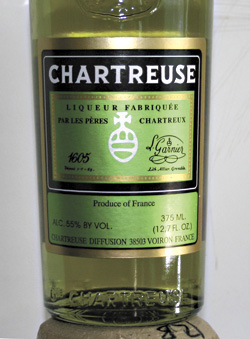Plenty of bottles languish on the average back bar, forgotten vintage accessories that could glitz up your drink if only you’d let them. Seattle’s cocktail renaissance, which has bartenders combing bar manuals of yore for recipes, is exciting for us bartenders precisely because these bottles are getting a little more action.
A century ago, ingredients we now take for granted, like pomegranates and a plentiful supply of limes, weren’t plentiful. If a bartender wanted to layer flavors into a drink, he used bitters, vermouths, and exotic monk-distilled liqueurs like Bénédictine and Chartreuse. These bottles acted like souvenirs of a faraway land, instantly making an average whiskey cocktail an extravagance.
Chartreuse predates cocktail culture by three centuries. An envoy to King Henri IV gifted the liqueur’s original recipe to Carthusian monks, who began distilling it in the French Alps, perfecting their recipe in the mid-1700s. Production was interrupted twice when the monks were expelled from the country, first in the late 1700s and again around 1900. When the French government seized their monastery the second time, the monks took refuge in Spain and continued making their version of Chartreuse under another name. However, the French government’s attempt to copy the drink failed, and townspeople rallied to buy the monastery property back for the brothers. It is said that only three monks ever know the true recipe at one time, each overseeing only part of the distillation.
The color of green Chartreuse (the original recipe) naturally results from the plethora of botanicals used to produce it. The aroma is sweet and a little savory, echoing the smell of gin mixed with mint. On the tongue, though, you won’t get an overwhelming mint or menthol flavor like the brain expects. Chartreuse tastes vaguely of many things: coriander, mint, orange peel, cardamom, fennel. Each sip offers a new hint of spice or herb. Seeing as how there are 130 different botanicals involved in distillation, it’s not purple prose to say Chartreuse smells like an Alpine meadow.
Drink Chartreuse on the rocks with a water back and use the water to dilute it, same as you would with Pastis. The water takes the edge off the alcohol, bringing out the liqueur’s full aroma and flavors. Try the Champs Elysees at Liberty (517 15th Ave. E., 323-9898), made with Courvoisier cognac, green Chartreuse, and lemon juice. It’s in the same vein as a Manhattan, with the Chartreuse doing the heavy lifting of both bitters and vermouth. The buttery burn of the brandy absorbs some of the high-toned, medicinal notes of the Chartreuse and lets the spice shine.
If you don’t see a Chartreuse drink on your local cocktail bar’s menu but spy the green bottle on its shelves, ask the bartender to use it, instead of bitters, in a pink gin. The clash of botanicals makes for an interesting ride over the taste buds, like a roller-coaster trip through every green smell you’ve ever known. There is also yellow Chartreuse, a honeyed, sweeter version whose recipe is a mere 175 years old. Next time you’re downtown for a nightcap, stop in at Campagne for a sip of it. Whatever you do, do not commit the same jackassery as Quentin Tarantino in his new movie, Death Proof; Chartreuse does not make for the best shot. This vintage lady doesn’t deserve treatment so gauche.





